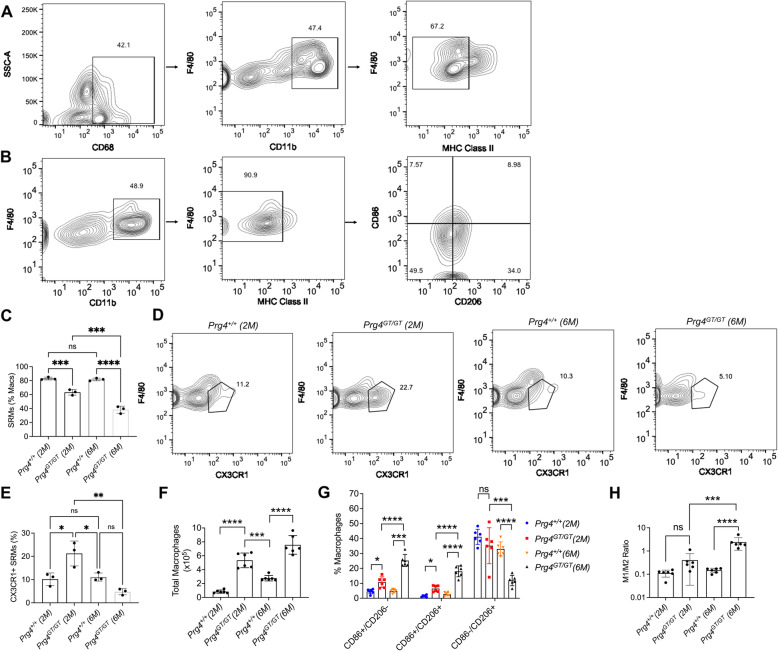Fig. 1.
Analysis of synovium-resident macrophages (SRMs) in the knee joints of 2- and 6-month-old Prg4 gene trap (Prg4GT/GT) and age-matched wildtype (Prg4+/+) mice and comparisons of total macrophages isolated from synovial tissues from both genotypes. SRMs were identified as CD68+ CD11b+ F4/80+ MHC class II− and expressed as % of total macrophages. The percentages of CX3CR1+ SRM subpopulation were analyzed as a function of age and genotype. Total macrophages were determined in cell suspensions of digested joint capsule tissues as described in the “Methods” section (CD11b+ F4/80+ MHC class II− CD86+ and/or CD206+). CD86 is a marker of inflammatory M1 macrophages while CD206 is a marker of anti-inflammatory M2 macrophages. In our flow cytometry analyses, singlets were initially gated using a combination of forward scatter height (FSC-H) and forward scatter area (FSC-A) and viable cells were subsequently identified using a viability dye (Zombie Violet) as shown in Supplementary Figure 2. Three animals per group were used to study SRMs (two males and one female), and six animals per group were used to study total synovial macrophages (balanced between males and females). In all experiments, independent biological samples were analyzed in duplicates, and the averages of both technical replicates were included in the analysis. We compared the ratio of M1 (CD11b+ F4/80+ MHC class II− CD86+/CD206−) and M2 (CD11b+ F4/80+ MHC class II− CD86−/CD206+) macrophages in synovial tissues across all experimental groups. Statistical analyses of SRMs, total macrophages, and percentages of CD86+ and/or CD206+ macrophages were performed using Student’s t test and one-way and two-way ANOVA, respectively. Tukey’s post hoc test was used in one- and two-way ANOVAs. ns non-significant; *p<0.05; **p<0.01; ***p<0.001; and ****p<0.0001. A Gating strategy was utilized to identify SRMs. B Gating strategy utilized to identify total macrophages in digested synovial tissues. C 2- and 6-month-old Prg4GT/GT joints contained lower percentages of SRMs compared to age-matched Prg4+/+ joints. D Representative flow cytometry contour plots showing CX3CR1+ SRMs from 2- and 6-month-old Prg4GT/GT and Prg4+/+ animals. E Percentage of CX3CR1+ SRMs in Prg4GT/GT joints declined as animals aged. F 2- and 6-month-old Prg4GT/GT synovial tissues contained higher numbers of total macrophages than age-matched Prg4+/+ synovia. G Prg4GT/GT joints had higher percentages of CD86+/CD206− and CD86+/CD206+ macrophages (2 and 6 months) and a lower percentage of CD86−/CD206+ macrophages (6 months) compared to age-matched Prg4+/+ joints. As Prg4GT/GT animals aged, their synovia contained higher percentages of CD86+/CD206− and CD86+/CD206+ macrophages and a lower percentage of CD86−/CD206+ macrophages. H M1/M2 ratio in synovial tissues from 6-month-old Prg4GT/GT animals was higher than the corresponding ratio in age-matched Prg4+/+ animals

